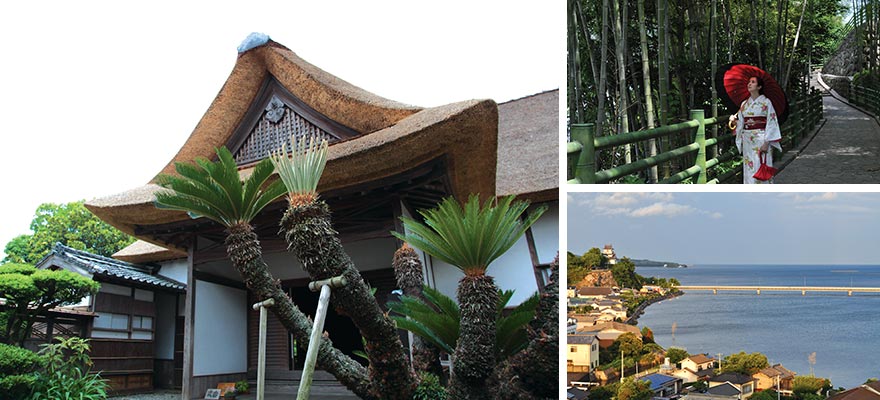Home > Highlighting JAPAN >Highlighting Japan July 2014> 47 Prefectures from A to Y
Highlighting JAPAN
47 Prefectures from A to Y
Oita
Kitsuki City—Edo Era Ambience

T here's a salty tang in the air in Kitsuki, situated on the southern coast of Kunisaki Peninsula in Oita Prefecture, Kyushu. Kitsuki Castle overlooks both the town and Morie Bay below. The sun warms the stone-paved streets and traditional clay-tiled roofs of the well-preserved nineteenth-century Edo Period town, where citizens can purchase miso and ceramics in shops over a century old and watch popular dramatic plays and dance performances, just as they did in bygone ages.
To immerse yourself in the experience, rent a kimono for the day and walk the streets in traditional style. At Waraku-an, for example, customers can choose from hundreds of styles and accessories and don their finery with the help of a kimono professional. Although most of the patrons are domestic tourists, Mitsuko Aoki, Waraku-an's kimono expert, says her shop is also popular among tourists from many different countries and regions. "Depending on the country, tourists choose different kimono, patterns and colors. For example, a seventy-year-old Japanese woman would never choose a red kimono, but someone from Thailand will."
Properly outfitted, we stroll down the main business thoroughfare, past shops selling tea and sweets. A pair of kindergartners playing in a front garden call out "Ohayo gozaimasu!" (Good morning!) as we pass. Shinichirou Kimoto, who works for the Kitsuki City Tourism Organization says, "Something that surprised me when I first came here is that all the kids, from preschool to high school, greet you in the street. It's that kind of place."
Soon we are in the old samurai residential districts perched on hills to the north and south. We enter a tatami-matted tearoom. A picture-perfect garden scene is visible, and a bush warbler calls from a maple tree. Brilliantly colored koi (carp) swim figure eights in the pond under the lily pads, and a gnarled pine tree stands beside a rough-hewn lantern made from stones brought in from the sea.
For lunch we sample tai-chazuke, a traditional delicacy that is a specialty of the region at Wakae-ya, a restaurant near the castle that has been serving the dish to shoguns, emperors and other diners for over three centuries. Wakae-ya layers thin slices of freshly marinated sea bream over a bed of rice, followed with its signature sesame soy sauce. Piping hot green tea is poured on top, and the dish is covered to steam for just three seconds before being eaten. Known for its simple, clean, fresh flavors, tai-chazuke is said to have made a Kitsuki feudal lord in the Edo Era exclaim "Ureshino!" (I'm happy!)
The roar of laughter can be heard coming from the old playhouse, Shurakukan, even from a few hundred meters away. Theater fans here express delight as acting troupes perform popular dramas and traditional dancing, at times mixing old plays and costumes with modern music. Artfully made-up men in gilded kimono flash sultry looks at the crowd as they perform fan dances, and fierce warriors with topknots put on a dazzling display of swordplay. The sixty-year-old man sitting next to us gives a nudge as a nineteen-year-old actor playing the oyama (female role) preens and pouts on the stage in a white and silver kimono. "This young guy is so cool," he murmurs.
After their performance the actors line up outside the entrance to thank the audience. As the happy theatergoers begin trickling down the street, some linger to chat while others turn into teahouses. The actors, still clad in their sumptuous robes and heavy stage makeup, bow and send the guests on their way. "Thank you very much!" they shout. "Come again soon!"
© 2009 Cabinet Office, Government of Japan






